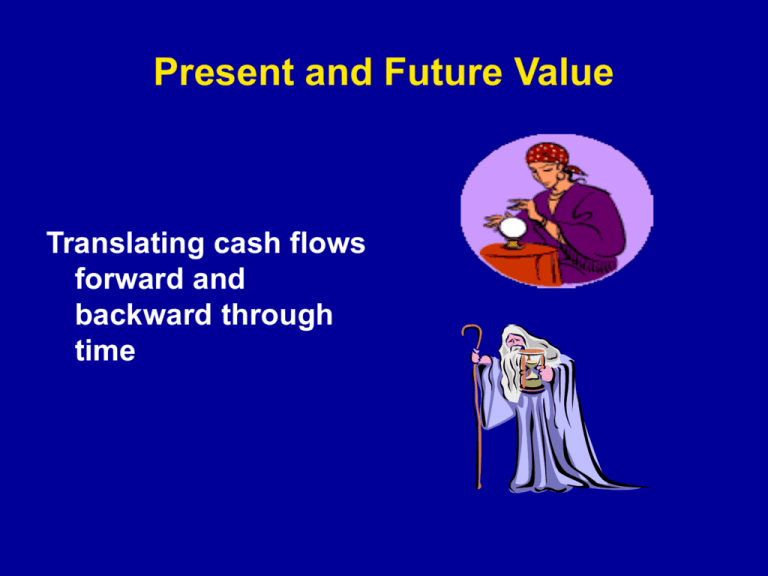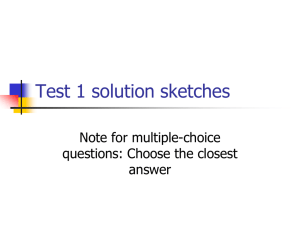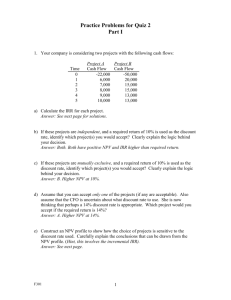Present and Future Value
advertisement

Present and Future Value Translating cash flows forward and backward through time Future Value FV P(1 r ) • Money invested earns interest and interest reinvested earns more interest • The power of compounding T Future Value Problems FV P(1 r ) T Solve for any variable, given the other three • • • • FV: How much will I have in the future? P: How much do I need to invest now? r: What rate of return do I need to earn? T: How long will it take me to reach my goal? Present Value FV P T (1 r ) • Discounting future cash flows at the “opportunity cost” (cost of capital, discount rate, minimum acceptable return) • A dollar tomorrow is worth less than a dollar today Present Values can be Added CF1 CF2 CFT P CF0 ... 2 (1 r ) (1 r ) (1 r )T 1 1 1 CF2 ... CF0 CF1 2 T 1 r ( 1 r ) ( 1 r ) CFT • Cash flows further out are discounted more • Discount factors are like prices (exchange rates) Calculating PV of a Stream (Beware) • Calculator assumes first CF you give it occurs now (Time 0) • Excel assumes first CF you give it occurs one year from now (Time 1) Different Compounding Periods APR (1 EAR) 1 m m • m = # of compounding periods in a year • APR = actual rate x m (APR is annualized) • EAR = the annually compounded rate that gives the same proceeds as APR compounded m times Semiannual Compounding 2 .10 1 1.1025 2 • m=2 • APR = 10% • EAR = 10.25% Quarterly Compounding 4 .10 1 1.1038 4 • m=4 • APR = 10% • EAR = 10.38% Monthly Compounding 12 .10 1 1.1047 12 • m = 12 • APR = 10% • EAR = 10.47% Daily Compounding .10 1 365 • m = 365 • APR = 10% • EAR = 10.516% 365 1.10516 Continuous Compounding m APR APR 1 e as m m e .10 1.10517 • m= • APR = 10% • EAR = 10.517% Annuities • All cash flows are the same, so we can factor out the constant payment C and calculate the sum of the discount factors C C C P ... 2 T 1 r (1 r ) (1 r ) 1 1 1 C ... 2 T (1 r ) 1 r (1 r ) Special Case: Perpetuity • If all the cash flows are the same each period forever, the sum of the discount factors converges to 1/r 1 1 1 P C ... 2 3 1 r (1 r ) (1 r ) C r Perpetuity Example • Let C = $100 and r = .05 • $100 per year forever at 5% is worth: 100 P 2000 .05 Other Perpetuity Examples • British Consol Bonds • Canadian Pacific 4% Perpetual Bonds • Endowments – How much can I withdraw annually without invading principal? Growing Perpetuity • Suppose the initial payment C grows at a constant rate g per period (where g < r) • This growing stream still has a finite present value: C C (1 g ) C (1 g ) P ... 2 3 (1 r ) (1 r ) (1 r ) C rg 2 Growing Perpetuity Example • Suppose the initial payment is $100 and that this grows at 3% per year while the discount rate is 5% • The value of this growing perpetuity is: C 100 P $5,000 r g .05 .03 Other Growing Perpetuity Examples • Stock price = present value of growing dividend stream (see Class #7) • M&A: How to estimate terminal value – How fast do earnings grow after the end of the analysis period? Finite Annuity= Difference Between Two Perpetuities 0 C 1 C 2 C 3 C 4 C 5 C 6 C 7 C 8 C C C C C P r P C 1 4 r (1 r ) C 1 difference 1 r (1 r )4 Annuity Example • What’s the value of a 4-year annuity with annual payments of $40,000 per year (@5%)? C P r 1 1 (1 r ) 4 40,000 1 1 141,838 4 .05 (1.05) Oops, Tuition Payments Due at Beginning of Year 1 1 P C 1 1 T 1 r (1 r ) 1 1 1 40,000 1 3 .05 (1.05) 148,930 141,838(1.05) Other Annuity Applications • Lottery winnings • Lease & loan contracts • Home mortgages • Retirement savings/ income Home Mortgages • 30-year fixed rate mortgage: 360 equal monthly payments • Most of early payments goes toward interest; principal repayment gradually accelerates • At any point: outstanding balance = present value of remaining payments More Annuity Problems Saving, Retirement Planning, Evaluating Loans and Investments Net Present Value (NPV) • Best criterion for corporate investment: • Invest if NPV > 0 NPV with a Single, Initial Investment Outlay T Ct NPV I t t 1 (1 r ) • • • • I = initial investment outlay Ct = project cash flow in period t r = discount rate (shareholders’ opp. cost) T = project termination period Implications of NPV > 0 T Ct I t t 1 (1 r ) • • • • Project benefits exceed cost (in PV terms) Project is worth more than it costs Project market value exceeds book value Project adds shareholder value NPV More Generally T Ct NPV t t 0 (1 r ) • Treat inflows as +, outflows as – • NPV = PV of all cash flows • Investment may occur throughout project life Internal Rate of Return T Ct I t t 1 (1 IRR ) • IRR sets value of benefits = investment • IRR sets NPV = 0 • IRR is the rate of return company expects on investment I NPV > 0 Implies IRR > r T Ct NPV 0 I t t 1 (1 r ) • If NPV > 0, IRR must exceed r • Investing when NPV > 0 implies company expects to earn more than shareholder’ opp. Cost • Equivalent: Invest when NPV > 0 or when IRR>I








